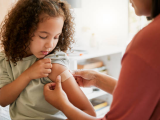Feb 1, 2013 (CIDRAP News) – The influenza vaccine that was developed to fight the 2009 pandemic saved roughly 300 lives and prevented about 1 million illnesses and 6,000 hospitalizations, or under 3% of the estimated total burden in each category, according to new estimates from the Centers for Disease Control and Prevention (CDC).
Those benefits would have been substantially higher if the vaccination program had begun a week or two earlier, the authors calculated. Because of difficulties growing the vaccine virus in eggs, the vaccine supply didn't flow freely until after the pandemic peaked in the fall of 2009.
The CDC has previously estimated that the 2009 pandemic H1N1 (pH1N1) virus caused about 61 million clinical illnesses in the United States, leading to around 274,000 hospitalizations and 12,500 deaths. About 81 million people received the vaccine, the agency estimates.
If the vaccination program could have started 2 weeks earlier than it did—the launch was at the beginning of October—the inoculation would prevented close to 60% more cases, the authors of the current study estimated. Starting the program 8 weeks earlier would have tripled the number prevented.
The authors, led by Rebekah H. Borse, PhD, MHS, undertook to estimate the benefits of the vaccination program from its advent in October 2009 until April 2010, a year after the virus was identified. They reported their study this week in Emerging Infectious Diseases.
Because of worries about the vaccine supply in the early months of the pandemic, the US Advisory Committee on Immunization Practices (ACIP) recommended that certain high-risk groups get priority for the doses: pregnant women, caregivers of babies, healthcare personnel, everyone between 6 months and 24 years old, children on long-term aspirin treatment, and adults 25 to 64 years with certain health conditions. Older people were less vulnerable to infection because of exposure to related viruses earlier in life.
The authors used population data and the epidemic curve traced by the weekly number of cases during the pandemic to build their estimates of the vaccine's impact. The epidemic curve published in the study shows that cases peaked at about 7 million per week in late October. The same graph shows that the rate of pandemic vaccinations peaked at approximately the same number about 1 week later.
The researchers divided the US population into eight subgroups according to age and risk factors such as pregnancy, contact with infants, and work in healthcare. With data from three flu surveillance systems, they estimated each subgroup's overall share and incidence of pH1N1 cases, hospitalizations, and deaths.
Estimates of vaccination coverage were based on two CDC surveys. For the vaccine's effectiveness, the authors relied on studies from Europe and China and expert opinion based on unpublished CDC studies. They estimated its effectiveness in preventing cases, hospitalizations, and deaths at 62% for all subgroups except people over 65, for whom the effectiveness was estimated at 43%.
In 2011, a study from the US Flu Vaccine Effectiveness Network estimated the overall effectiveness of the pH1N1 vaccine at 56%. Martin I. Meltzer, MS, PhD, of the CDC, senior author of the current study, said that estimate was not yet available when his team started its research. When the 56% estimate did come out, his group felt that it wasn't different enough from the 62% to warrant revising the work they had already done.
"A difference between 56 and 62[%] is not going to make a big difference in the overall policy conclusions," Meltzer told CIDRAP News. He said the confidence intervals for the two estimates overlapped enough to say they are "technically not different."
Other assumptions included in the model were that it took 2 weeks for the vaccine to fully protect vaccinees and that 30% of pH1N1 infections were subclinical.
After running a series of equations, the authors concluded that the vaccination program directly prevented from 712,998 to 1,458,930 cases, from 3,923 to 10,393 hospitalizations, and from 201 to 520 deaths. They list 1 million cases, 6,000 hospitalizations, and 300 deaths as midrange estimates.
In looking at results by vaccination target groups, the analysis showed that, on the basis of how many vaccinations it took to prevent one bad outcome, the program was most valuable for pregnant women and for people ages 25 to 64 years who had underlying health conditions.
About 60% of the illnesses prevented were in children and young people (6 months to 24 years) and in 25- to 64-year-olds with a higher risk of flu complications, including pregnant women, the authors concluded.
They used sensitivity analyses to assess how changes in certain variables might have affected the vaccine program's impact. If the program had started just a week earlier, it would have prevented about 27% more cases, the analysis showed. Starting 2 weeks earlier would have prevented 59% more cases, and starting 8 weeks earlier would have forestalled 306% more.
If the vaccine had been more effective—85% for everyone under 65 and 55% for older people, instead of the estimated 62% and 43%—the campaign would have prevented 38% more cases, according to the researchers' model. If the vaccine effectiveness had been only 40% in younger people and 20% in older, it would have prevented about 38% fewer cases.
The authors also used sensitivity analyses to look at the possible effects of vaccine prioritization strategies other than the one that was used. The general conclusion was that "the effects of the 2009 ACIP recommendations were similar, and for some subgroups even better, than those for other strategies," the report says.
"We found that the effects of the vaccination program were greatly influenced by the timing of vaccine administration and by vaccine effectiveness," it states.
Lone Simonsen, PhD, an epidemiologist and research professor in the Department of Global Health at George Washington University, who was not involved in the study, said she believes the estimates it presents are reasonably accurate, though she had a few reservations.
"The modeling strategy is fine, but I think the authors are perhaps too optimistic about how fast the vaccine was rolled out, especially in adults who were not high risk," she commented by e-mail. "I remember trying to get the vaccine myself in late November and [being] told that I would have to wait since I was not high risk! Also the timing of the epidemic pattern is not true to the southern US, where the first and only wave peaked in September and was certainly mostly over by the time the vaccine became available.
"But having said all that, I am thinking the bottom line estimates are probably about right." She added that the CDC's top estimates of 10,000 saved hospitalizations and 500 prevented deaths are a little less than 5% of the approximately 300,000 hospitalizations and 15,000 deaths that were attributed to the pandemic virus in the United States in 2009.
Simonsen said the findings should be considered in the context of the total hospitalizations and deaths. "While the prevented burden seems impressive, it only represents about 5% of all the severe outcomes caused by the pandemic virus that winter," she said.
Borse RH, Shrestha S, Fiore AE, et al. Effects of vaccine program against pandemic influenza A(H1N1) virus, United States, 2009-2010. Emerg Infect Dis 2013 March;19(3) (Early online publication) [Full text]
See also:
2011 PLoS One study estimating pH1N1 vaccine effectiveness at 56%


















